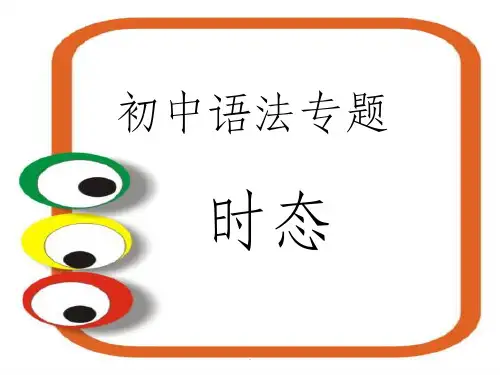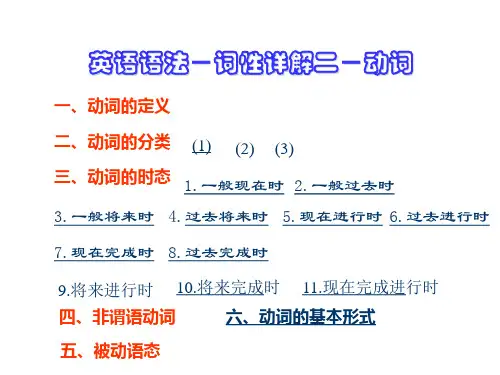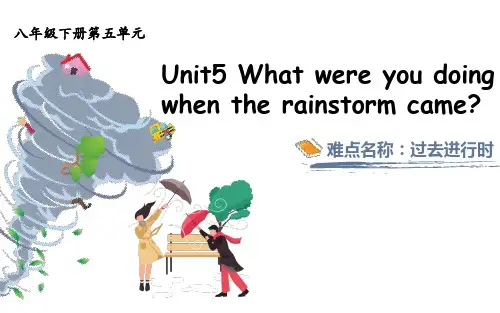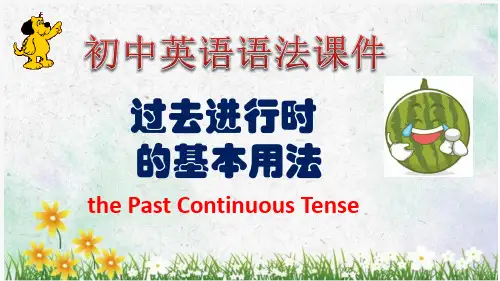八年级英语过去进行时课件1
初中英语8大时态ppt课件

e.g.Has she any experience in teaching piano lessons?(√) Does she have any experience in teaching piano lessons? (√) 她有教钢琴的经验吗?
Had you a good time going hiking yesterday?(×) Did you have a good time going hiking yesterday?(√)
you/ they working?
.
Is he/ she/ it not working?或Isn’t
he/ she/ it
working?
现在分词的变法有:
1)、一般在动词词尾加上-ing , E.g. jump---jumping
2)、以不发音字母e结尾的动词,先去e,再加ing. E.g have---having
表示过去经常发生的动作,也 可用“used to do ”和“would +动词原形”。
.
肯定式
疑问式
否定式疑问否定式I源自wasateacher.
Was I a I was not
teacher? teacher.
a
Was I not a teacher?
He/ She was a
teacher.
It was Mary.
We/ You/ They
were teachers.
Were we/ We/ You/ They Were we/ you/ they not
you/ they were not/
teachers?或Weren’t we/
teachers?weren’t teachers.you/ they teacher?
英语时态8种基本时态讲解.ppt课件

8.过去完成时 表示动作发生在过去某一时间之前已经完成的动作或状态, 强调“过去的过去”, 常与 by the time, by the end of…,before , by 等引导时间的状语连用。
基本结构 主语+ had + 动词过去分词 + 其他成分 When I got to the cinema yesterday the film had begun already. He had learned English before he came here.
现在完成时与一般过去时的区别: 1)现在完成时侧重于对现在的影响;而一般过去时侧重于某一动作发生在过去某个时间或某段时间。即现在完成时侧重于现在的结果,而一般过去时侧重于动作发生的时间。例如:
I have seen the film. 我看过这部电影。(现在我仍记得电影的内容) I saw the film three days ago. 三天前我看了这部电影。(强调是三天前,而不是别的什么时候看的电影)
be going to含有“打算,准备”的意思,而will则没有这个意思, She is going to lend us her book. He will be here in half an hour.
be about to+V.原形(意为马上做某事,在时间上指最近的将来) I am about to leave school. 不能与表示时间的副词连用。 They are about to set out.(√) They are about to set,变y为i加-ed. study----studied carry----carried cry----cried try----tried d)以元音字母+y结尾的单词直接加-ed. play----played stay----stayed
互动课程:初二英语-过去进行时[1]
![互动课程:初二英语-过去进行时[1]](https://uimg.taocdn.com/11f99dc1d5bbfd0a79567344.webp)
10. counter-反,逆,副(加在名词、动词前) 加在名词、动词前) 反 counterattack (反攻,反击), counterrevolution (反革命 反攻,反击 反革命) 反攻 反革命
1. Put the cart before the horse. 本末倒置
七、(2010,乌鲁木齐)根据短文内容,填写一个适 、( ,乌鲁木齐)根据短文内容, 当的词,使短文意思完整且符合逻辑。(每空一词) 。(每空一词 当的词,使短文意思完整且符合逻辑。(每空一词) 5. different A young man wanted to learn how to be a good farmer. He went to a (1) who agreed to help. Every day for a month, he sat by the teacher, who talked (2) farming for eight (3). The young man was very bored and felt very disappointed. 1.teacher 2. about 3. hours 4. another Then he went to (4) teacher. This time the teacher was (5) from the first one. He didn't talk to the boy. The boy sat there next to the teacher for hours.
动词时态课件(1)

我们时常相互通信。
常与always,usually,often,sometimes,every day,once a week,yearly 每年,monthly每月, 等时间状语或频率副词连用。
(2)表示主语现在的性格、特征、能力 eg.He works hard.他努力工作
(3)表示客观事实或普遍用法
分 现在分词 词作用,表主 状语、宾语补足
词
动
语
起形容词、副 过去分词 词作用,表被
动
The steam is seen rising from the wet clothes.
一般现在时 : 一般过去时
am is are
was were
do(does)
did
1.一般现在时
(1)表示经常发生或习惯性的动作或状态 eg.We often write to each other.
②主语+was/were+going to +动词原形
例:I didn’t know if she would come. I wasn’t sure whether he would do it . I didn’t know if she was going to come. Wang Lei said that she was going to visit
返回
三、按动词的形式可以分为谓语动词和非谓语动词
1、谓语动词(如下)
2、非谓语动词
形式
意义
与主语在人称一致 人称
举
例
I am reading now. 第一人称
数 时态 语态
语气
与主语在数上一致
He writes well. 第三人称单数
人教PEP八年级英语下册第五单元 过去进行时

When和while的区别
长动作
长动作
3.I was watching TV while my mother was cooking.
主句
从句
主句和从句的动作在过去的某时刻或某时段同时发生,而且动
作都是持续性的,此时用_w__h_i_l_e__引导从句,并且主句和从句
表示一个动作发生 时,另一个动作正 在进行: eg. When my mum came home, I was sleeping.
表示一个动作正在 进行,另一个动作突 然发生: eg. When I was walking, it rained.
表示过去某一时刻 正在进行的动作: eg. I was drawing at that time yesterday.
过去进行时(Past continuous tense)
定义:表示在过去某一时刻或某一段时间内正在进行的动作或存在的状态。
结构:主__语__+__b_e_(w_a_s_/_w_e_r_e_)+__动__词__的__现__在__分__词___ (was用于__单__数__主__语___, were用于_复__数__主__语__和_y_o_u__)
巩固练习
3. __W__h_e_n___ I arrived at the airport , the plane was taking off. (when/while) 4.He fell asleep ___w__h_i_le___ he was reading. (when/while)
Summary 小结
3.I was watching TV while my mother was cooking.
初中英语语法课件-过去进行时的基本用法

the Past Continuous Tense
过去进行时
定义:
过去进行时是表示 过去某个具体时刻正在 进行的事情或动作的时 态。
标志词 at the time, at that time ,at this time yesterday at 9:00 yesterday morning, (just)then,yesterday afternoon, the whole morning,all day yesterday,those days, from 9 to 10 last evening/night
3. 一般疑问句:Was/were+主语+v-ing形式+其他成分? Were you playing the piano at eight last night? 你们昨晚8点钟在弹钢琴吗?
一般疑问句的回答肯定回答: Yes,主语+was/were. 否定回答:No,主语+was't/weren't. Were you playing the piano at eight last night? 肯定回答-Yes, we were. 是的,我们在弹钢琴。 否定回答-No,we weren't. 不,我们没有在弹钢琴。
4.特殊疑问句:疑问词+was/were+主语+v-ing形式+其它? —What was he doing at this time yesterday? —He was reading books.
用法:
1.过去进行时表示过去某段时间内持续进行的动作或者事情。 We were watching TV from seven to nine last night. 昨天晚上七点到九点的时候我们在看电视。 What was he researching all day last Sunday? 上周日他一整天都在研究什么? I was watching the football match at 10:00 last night. 昨晚10点我在看足球赛。
中考英语语法复习过去进行时知识点(共17张PPT)
3.My brother ___ while he ___ his bicycle and hurt himself. A.fell,was riding B.fell,were riding C.had fallen,rode D.had fallen,was riding 4.Tom ___ into the house when no one ___. A.slipped,was looking B.had slipped,looked C.slipped,had looked D.was slipping,looked
典型例题:I ______ (write) a letter at ten last night. 解析:所给的时间状语at ten last nigh“昨天晚上十点钟”是具体的过去 的某一时刻,所以应该用过去进行时。 答案:was writing
典型例题1:Mary a dress when she cut her finger. A. made B. is making C. was making D. makes 解析:割伤手指是已发生的事情,应用 过去时。同时,when表时间的同时性 ,表示“割伤手指”的时候“玛丽做衣 服”的动作正在进行,它提供事情发生 的背景,因此用过去进行时。 答案C.
9.The reporter said that the UFO ___ east to west when he saw it. A.was traveling B.traveled C.had been traveling D.was to travel 10.I ___ my breakfast when the morning post came. A.had B.had been having C.have been having D.was having
英语时态:过去进行时
英语时态:过去进行时过去进行时(Past continuous tense或Past Progressive tense),表示过去的某一时刻或者一段时间正在进行的动作或存在的状态,这个动作或状态是在过去时间里正在进行的。
时间点可以是介词短语,可以是副词,比如:at ... o’clock last night,at that moment等。
Ⅰ. 句法结构:1.陈述句:be动词过去式+ doingA. 肯定形式:主语+was/were +doing+其他B. 否定形式:主语+was/were not+doing+其他注:be动词was和were在进行态结构中作助动词,不构成实际含义,而行为(实义)动词同一以doing形式存在在结构中,所以相对应的人称变化和句式结构变化全部体现在be动词上。
【同现在进行时】2.疑问句:A. 一般疑问句:be动词提前即可Was/Were+主语+doing+其他B.特殊疑问句:特殊疑问词+一般疑问句(同上)3.被动语态:主语+ was/were + being +done +其他【被动结构be done,时体现在助动词】➢两态变化例句参考下表:Ⅰ. 主要用法:1.(基本用法)过去进行时主要表示过去某一时间正在进行的动作。
He fell asleep when he was reading.2.用于描写故事情景,或提供故事发生的时间背景。
The fire was burning. Children were crying. Women were running about and men were trying to put it out.3.用过去进行时表示现在,主要是为了使语气委婉、客气。
此类动词主要有hope, wonder, think, expect等。
【一般过去时也有类似用法,但比较而言,用过去进行时显得更客气,更加不肯定。
】I was wondering if you can give me a hand.4.表示从过去某一时间看将要发生的动作,常表示过去“渐渐”、“快要”、“越来越”、“马上”等含义,常见的此类动词有come,go,start,begin,leave,arrive,get,become,turn等非持续性(位置的瞬间移动或状态的瞬间改变)动词,偶尔有些持续性动词如do,stay,take 等常表示过去“将要”。
《过去进行时》课件
过去进行时的否定句在 was/were后面加not,例如"He was not singing at 7 o'clock"
。
过去进行时的疑问句将 was/were提前,例如"Was he playing basketball at 4 o'clock
?"。
强调过去进行时的特殊用法
过去进行时可以用来表示一个动 作在过去某个时间点之前已经完 成,强调该动作在过去某个时间
过去进行时通常与时间状 语连用,如"at 9 o'clock yesterday morning"。
过去进行时可以用来描述 一个动作在过去的某个时 间点之前已经开始,并在 那个时间点还在进行。
总结过去进行时的句型变换规则
基本句型为"was/were + -ing" ,表示过去正在进行的动作或存
在的状态。
表示过去某个时间段内一直在进行的动作
总结词
描述过去某一段时间内持续进行的动作
详细描述
过去进行时可以用来表示过去某一段时间内一直在进行的动作,强调动作的持续性。例如 ,“She was writing a letter for hours before she finally finished it.”(她花了几个 小时一直在写信,最后终于写完了。)
03
翻译题2: 请将下列英文句子
翻译成中文,并使用过去进行
时态。
04
She was singing a song when her brother interrupted her.
05
答案:她正在唱一首歌,这时
她的哥哥打断了她。
06
07
初中英语过去进行时讲解课件(共36张PPT)
II:用法
• 1. 表示过去某一时刻正在进行的动作。
• 今天下午5点的时候,他在打篮球。
He was playing basketball at 5 this afternoon.
当我进去的时候,她正在写一篇作文。
She was writing a composition when I entered.
8.Shirley ___ a book about China last year but I don’t know whether she has finished it. A.has written B.wrote C.had written D.was writing
9.I first met Lisa three years ago.She ___ at a radio shop at the time. A.has worked B. was working C.had been working D.had worked
-What was Lilei drawing when the teacher came in? -He was drawing an elephant.
-What were the twins drawing when the teacher came in? -They were drawing a car.
2. 表示过去一段时间内持续进行的动作。
昨天夜里下了一夜的雪。
It was snowing last night.
比较:
It was said that she was writing a novel last year.
据说,她去年一直在写一本小说。
- 1、下载文档前请自行甄别文档内容的完整性,平台不提供额外的编辑、内容补充、找答案等附加服务。
- 2、"仅部分预览"的文档,不可在线预览部分如存在完整性等问题,可反馈申请退款(可完整预览的文档不适用该条件!)。
- 3、如文档侵犯您的权益,请联系客服反馈,我们会尽快为您处理(人工客服工作时间:9:00-18:30)。
—— 过去进行时
I. 构成 : was/were + - ing wasn’t/weren’t +-ing
II. 用法 :
1. 表示过去某一时刻正在进行的动作。
+ 今天下午5点的时候,他在打篮球。
He was playing basketball at 5 this afternoon.
2. 表示过去一段时间内持续进行的动作。
昨天夜里下了一夜的雪。
It was snowing last night.
2. 表示过去一段时间内持续进行的动作。 比较: It was said that she was writing a novel last year.
据说,她去年一直在写一本小说。
It was said that she wrote a novel last year.
据说,她去年写了一本小说。
一般过去时
VS
过去进行时
都是表示过去的发生的动作!
一般过去: 叙述过去发生的事
过去进行:强调过去正ຫໍສະໝຸດ 发生的动作区别— 定义一般过去时: 过去的某个时间发生的动作或存在的状态。 过去进行时: 过去的某个时间点或时间段正在发生的动作。
homework
用一般过去时或过去进行时填 空。 1.I don’t want to go to the zoo today because it is raining. The same thing happened yesterday. I (want ,not) ____ to go to the zoo because it (rain)____.
Mr. Smith.
Lisa
Amy
Andrew
the Carters
区别二 动作状态
一般过去时: 往往表示某一动作已经完成。 过去进行时: 表示动作持续性或不知是否完成。 They built a bridge last winter. (已经建成了)
They were building a bridge last winter . (可能还未建成)
区别三 句式结构 1.一般过去时 was/were ,did,had Jordan was a basketball player ten years ago. 2.过去进行时 was/were + doing Yao Ming was playing basketball at 9:00 last night.
Mr. Smith was murdered last night. Suppose you are the police officer. You’ve found out what his neighbours were doing at 8 yesterday evening. This is your report:
be动词:was/ were
一般过去时
“ 有 ”动 词
存在有:There was/were
人拥有:had
行为动词:went , came…
过去进行时:was/were + doing
区别四 —时间标志词:
一般过去时 过去进行时
1.In 1999 2.three years ago st Monday
1.at 8:00 yesterday 2.at this time yesterday 3.at this time last year(Monday, month)
4.yesterday morning afternoon, evening , 4.at 9:00 last night night)
2.I (call)____ Roger at nine last night, but he (be,not)____at home.He(study)____ at the library.
3.I(hear,not)______the thunder during the storm last night because I (sleep)____.
